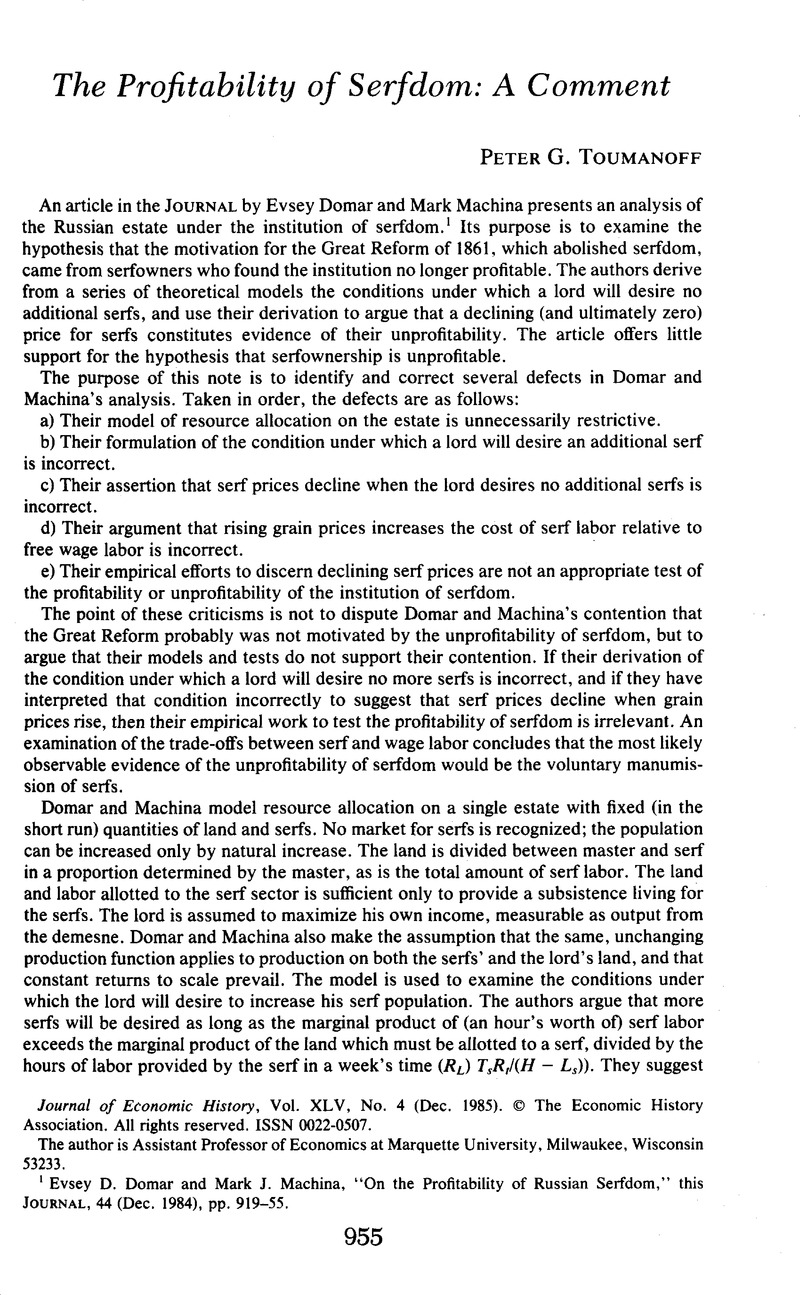No CrossRef data available.
Article contents
The Profitability of Serfdom: A Comment
Published online by Cambridge University Press: 03 March 2009
Abstract

- Type
- Notes and Discussion
- Information
- Copyright
- Copyright © The Economic History Association 1985
References
1 Domar, Evsey D. and Machina, Mark J., “On the Profitability of Russian Serfdom,” this Journal, 44 (12 1984), pp. 919–55.Google Scholar
2 Domar, Evsey D. and Machina, Mark J., “On the Profitability of Russian Serfdom,” this JOURNAL, 44 (12 1984)., p. 926.Google Scholar
From (5) we get (b):
From (6) we get (c):
From (7) we get (d):
Substituting (b) and (c) into (d) and rearranging and simplifying given us
Recognizing that FT.!F1. equals Gtm/Glm. and substituting (e) into (a) yied equation (9).
4 The Second, Third, and Fourth Models described by Domar and Machina are easily incorporated into the model presented here. Paul's Law, of the Second Model, adds the constraint that L m/S ≤ K. The Inventories of the Third Model can be approximated as the constraint that T s/L m ≥ C. The symbols K and C represent constants. The possibility of placing serfs on the obrok or quitrent system of obligations, treated in the Fourth Model, changes the problem of the lord to one of maximizing the larger of S(F(T/;S) – E) or w(S – L s). The latter is subject to F(T,L s) = ES. In this formulation w is the daily wage a serf can earn, and S and L s are measured in serf-days. For the former, the production of a serf household on the plot allotted to it is designated as F(T/S).Google Scholar
5 To be more exact, they identify the marginal cost of an hour of serf labor as the marginal product of the land which must be devoted to each serf averaged over the number of hours of labor each serf provides to the lord.
6 Observing a zero price for serfs is equivalent to voluntary manumission. One wonders why the lack of widespread manumission before the Great Reform is not sufficient refutation of the hypothesis that serfdom was no longer profitable.
7 See Fogel, Robert and Engerman, Stanley, Time on the Cross (Boston, 1974), vol. 1, pp. 232–46;Google Scholar and Barzel, Yoram, “An Economic Analysis of Slavery,” Journal of Law and Economics, 20 (04 1977), pp. 87–110.CrossRefGoogle Scholar
8 I have shown elsewhere that many of the institutions of serf ownership (including communal organization, the collection of barshchina, and the practice of repartition of peasant fields) may be explainable as cost-minimizing means of enforcing serf labor input and of providing a subsistence existence. See Toumanoff, Peter, “The Development of the Peasant Commune in Russia,” this Journal, 41 (03 1981), pp. 179–84.Google Scholar
9 See Confino, Michael, Domaines et seigneurs en Russie (Paris, 1963).Google Scholar


